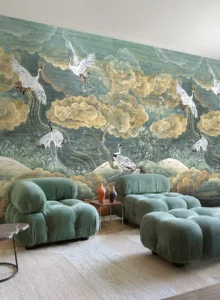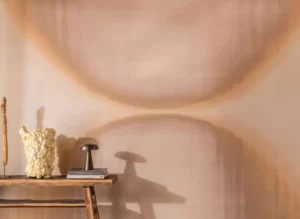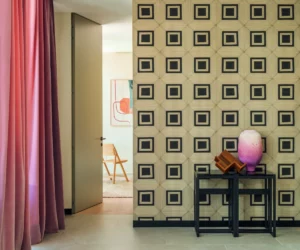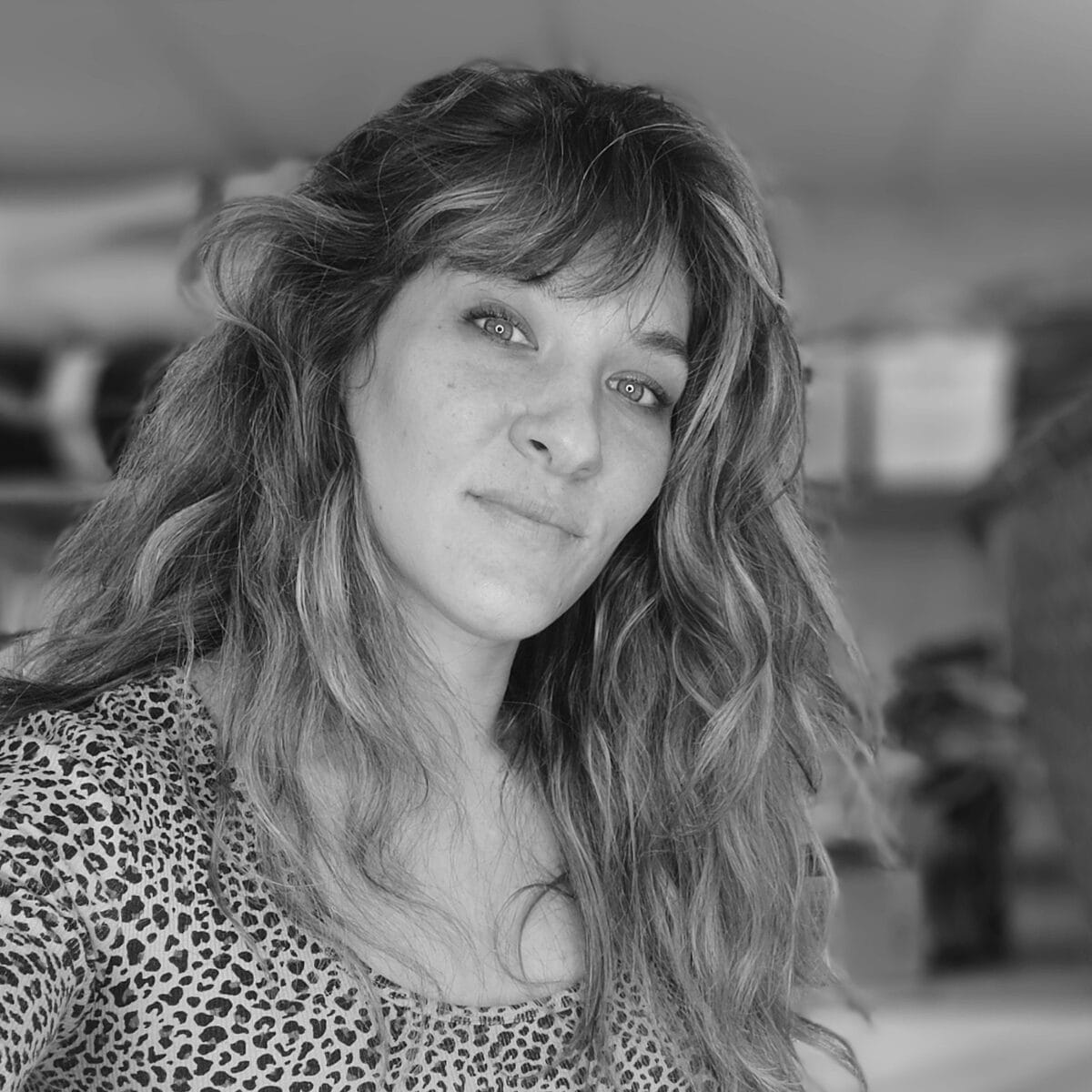Whether they imitate silky velvet, display the roughness of natural sisal, or reproduce the minerality of polished concrete, these textured wall coverings offer infinite decorative possibilities. They allow you to create varied atmospheres, from cozy cocoons to contemporary elegance, through natural spirit or industrial aesthetics. But beyond purely aesthetic aspects, choosing a textured wall covering requires understanding the specificities of each material family, their practical advantages, maintenance constraints, and relevance according to your interior spaces.
Wall coverings have undergone a quiet revolution in recent years. Gone are the days when wallpaper was limited to simple printed decoration, plastered on partitions like a flat image. Today, manufacturers compete in ingenuity to offer surfaces that are touched as much as they are seen, that dialogue with light, that radically transform a room’s atmosphere through their physical presence alone. This quest for material, texture, and relief responds to a deep need in our contemporary interiors: to reintroduce the sensory, the tactile, the authentic into spaces often too smooth, too refined.
Organic finishes constitute the latest trend in wall coverings: polished concrete effects, lime plaster, natural stone, oxidized metal—all these mineral textures so prized in contemporary architecture are now available in easy-to-install wall versions. A raw concrete effect wall in structured vinyl brings industrial spirit without the technical constraints and weight of real concrete.
How to choose your textured wall covering?
Before selecting a textured wallpaper, several essential criteria deserve consideration. The covering’s destination constitutes the first determining filter: a bedroom wall doesn’t impose the same constraints as a kitchen or bathroom. Humidity, splashes, frequent passage, available natural light are all parameters that will guide your choice toward one material category or another.
Investment obviously represents a decisive factor. Textured coverings present considerable price range, reflecting the nobility of materials used, their production complexity, and durability. Textured vinyl starts around forty euros per square meter, while rare natural weaving or exceptional textile wall hangings can easily reach four hundred euros, or more for custom creations from major houses.

Maintenance constitutes another crucial aspect, often underestimated during acquisition. A magnificent textile velvet that divinely captures light can prove demanding in daily life if your interior welcomes children or pets. Conversely, a washable structured vinyl will offer appreciable serenity in high-traffic areas. Finally, the desired aesthetic result will naturally guide your selection: are you seeking luxurious sophistication, natural authenticity, or technical modernity?
Textile: for what ambiance and which rooms?
Textile-effect wall coverings probably embody what’s most refined in contemporary wall decoration. Their capacity to create an enveloping atmosphere, almost cocoon-like, makes them precious allies for spaces dedicated to rest and intimacy. The velvet effect represents the summit of this family: its dense and deep surface captures light extraordinarily, creating shadow and brightness games that evolve throughout the day. In a south-facing bedroom, a textile velvet-covered wall becomes a true luminous stage where reflections glide and dance according to viewing angle.
Fabric and weave imitation wallpapers
Fabric and weave imitations propose a different, more structured approach. You can discern the weft, the interweaving of threads, sometimes even the irregularity characteristic of artisanal weaving. These coverings excel in contemporary living rooms, where they bring discreet sophistication without velvet’s theatricality. Interior architects particularly appreciate them for executive office walls or character hotels, creating simultaneously professional and warm atmospheres.

Real textile wallpapers
Among publishing houses that excel in textile effects, Dedar recently launched superb wall coverings that transcend applied textile codes. The Italian manufacturer, renowned for exceptional upholstery fabrics, transposes its expertise into wall collections where material achieves remarkable density.
Some wall coverings are genuinely composed of fabric applied to a wallpaper base, like this silk-effect wall covering signed Manuel Canovas.

The advantages of genuine textile coverings are numerous: remarkable sound insulation thanks to thickness and fibrous structure, immediate visual warmth, luxurious touch that invites contact, material nobility that enhances the entire space. In an urban apartment where noise constitutes daily nuisance, a textile wall can considerably improve a room’s acoustic comfort.
Velvet flocking represents a particularly interesting subcategory: short synthetic fibers are electrostatically deposited on vinyl support, creating soft touch and visual depth that evokes textile velvet for significantly more accessible investment. This technique produces luxurious effects for sixty to one hundred fifty euros per square meter, perfect for creating spectacular accent walls in budget-conscious projects.
These qualities justify an investment generally between one hundred twenty and four hundred euros per square meter installed, depending on quality and origin. Maintenance also poses questions: most of these coverings poorly tolerate humidity and require regular dusting with soft-brush vacuum. Stains are difficult to treat without leaving halos.
Finally, prolonged UV exposure can alter colors, particularly on bright shades. These constraints generally reserve them for bedrooms, libraries, dressing rooms, or well-maintained living rooms, absolutely avoiding kitchens, bathrooms, and humid rooms. Their lifespan, if usage conditions are respected, ranges between ten and twenty years, or more for the most qualitative creations.
Fabric Walling should also be mentioned as an alternative for the most ambitious projects: genuine fabric stretched on a frame or directly applied to the wall, offering depth and authenticity that even the best imitations struggle to equal. Major upholstery textile houses now offer simplified installation systems that make this option accessible to exceptional interiors. The investment remains substantial—count between two hundred fifty and six hundred euros per square meter depending on chosen fabric—but the result achieves a truly architectural dimension.
Natural: the ecological and authentic choice
Natural fiber wall coverings experience considerable enthusiasm, driven by authenticity seeking and growing environmental concerns. But let’s be clear from the start: these materials address enlightened enthusiasts, capable of appreciating imperfection as quality rather than defect. If you seek invisible seams and perfect uniformity, orient yourself toward other solutions. Natural fibers assume their living character, their color variations, their weaving irregularities that precisely constitute their charm and singularity.
Sisal perfectly embodies this philosophy: this fiber extracted from agave leaves offers rough, almost raw texture that immediately evokes craftsmanship and manual work. Its irregular weaving constitutes its aesthetic signature. Each panel presents density, color, thickness variations that make it unique. Seams never completely disappear; they’re integral to the aesthetic, like visible joints of dry stone wall. This acceptance of imperfection reflects certain decorative maturity, a capacity to value authentic over standardized.

Sisal integrates equally well into ethnic-inspired interiors and contemporary spaces seeking to temper their mineral rigor with organic touch. A loft with raw volumes partially dressed in natural sisal immediately gains warmth without losing modernity. Sisal’s natural shade, that golden beige slightly greenish, harmoniously matches practically all color palettes. Investment generally ranges between eighty and one hundred eighty euros per square meter depending on weaving quality and origin.

Japanese straw represents another facet of natural coverings, more refined, more precious. Derived from millennial Japanese interior decoration tradition, it comprises thin rice straw strips woven on paper support. The result possesses subtle translucency that magnificently diffuses light, creating peaceful atmosphere conducive to meditation. Here again, chromatic variations from one strip to another don’t constitute defects but testify to material’s natural origin. In zen-spirit bedroom or wellness space, Japanese straw instantly establishes contemplative ambiance. Count between one hundred twenty and two hundred eighty euros per square meter for authentic qualities.
Other natural fibers enrich this family: linen offers textile softness, hemp its more rustic character, Philippine abaca its exceptional resistance and fine texture, raffia its exotic aspect. Some editors even propose innovative blends, combining multiple fibers to create unprecedented textures marrying each one’s qualities.
Among publishing houses that distinguish themselves in natural fibers domain, Nobilis and Elitis propose remarkable collections where material authenticity meets contemporary creative sensibility. Masureel, for its part, publishes superb Japanese straws and sisals that rank among European market’s most qualitative, with particular attention to fiber selection and weaving regularity.
These natural coverings’ assets respond to most demanding contemporary expectations. Their ecological balance remains favorable, fibers being renewable and manufacturing process generally low-polluting. Each panel is unique, guaranteeing truly personalized decoration, impossible to identically reproduce. Natural fibers breathe, regulate ambient humidity, and contribute to indoor air purification. Finally, they perfectly embody biophilic trend aiming to reintroduce nature into our urban living spaces.
These materials’ particularities nevertheless require understanding and acceptance. Beyond already mentioned visual irregularities, seams between strips remain perceptible—it’s in the very nature of these artisanal or semi-artisanal weavings. Some fibers may slightly deform according to room humidity, requiring installation by experienced professional who will anticipate these movements. Installation generally requires qualified craftsman intervention, adding between forty and eighty euros per square meter to material costs. Maintenance-wise, simple regular dusting suffices, but stains are practically impossible to treat without leaving indelible marks.
These natural coverings find their ideal place in bedrooms, living rooms, libraries, and relaxation spaces, always on perfectly dry walls away from direct humidity sources. They’ll willingly be used as accent walls rather than complete room coverage, their strong visual presence and cost possibly justifying this targeted approach that further values their exceptional character.
Synthetic: technical performance
Synthetic wall coverings have considerably progressed in recent decades, rivaling their natural counterparts aesthetically while offering undeniable practical advantages. Textured vinyl constitutes this category’s spearhead: thanks to sophisticated printing and embossing techniques, it reproduces with troubling fidelity the appearance of textile, stone, raw concrete, or even natural fibers. Some imitations are so accomplished you must approach within centimeters to detect their synthetic nature.
Among editors distinguishing themselves in synthetic material effects domain, Nobilis and Elitis propose collections where technology recreates not only visual aspect but also tactile relief of noble materials, with sometimes stunning results. Their research on supports and printing techniques produces coverings that transcend simple imitation to propose genuine contemporary reinterpretation of natural textures.

The collaboration between Elitis and Véronique de Soultrait perfectly illustrates this approach: the textile artist brings her pictorial sensibility, her work on layer superposition and visual depth, while Elitis transposes this vision into wall coverings where material effects achieve remarkable richness. Created surfaces oscillate between lyrical abstraction and tactile sensuality, with subtle reliefs that magnificently catch light.

Investment obviously constitutes a weighty argument: rates oscillate between fifty euros per square meter for entry-level models and two hundred euros for high-end versions perfectly imitating noble materials. Finally, installation can be performed by standard installer, these materials forgiving approximations more than their noble equivalents. Seams, unlike natural fibers, completely disappear when installation is correctly executed.
These materials’ limits shouldn’t be overlooked. Aspect can sometimes betray certain artificiality, particularly on natural material imitations where mechanical pattern repetition ends up being perceived by trained eye. Touch, despite technical progress, generally remains less satisfying than genuine textile or natural fiber—this difference especially shows in intimate spaces where you’re led to brush walls. Environmental questions also arise: PVC, chemical glues, problematic recyclability—these materials have less favorable ecological balance, an aspect that matters for impact-conscious projects.
These synthetic coverings excel in technical rooms: kitchens where you can clean cooking splashes, bathrooms if choosing models specifically designed to resist humidity, entryways where frequent passage prematurely wears more delicate materials. They also perfectly suit rental housing where investment-resistance ratio trumps material nobility. In contemporary living room with controlled budget, concrete-effect vinyl accent wall can create remarkable visual impact for contained investment.
Non-woven: the practical and elegant compromise
Between authentic natural fibers and technical vinyls, non-woven establishes itself as particularly relevant intermediate solution for those seeking both aesthetic quality and usage ease. This support, composed of cellulose and polyester fibers bonded without weaving, revolutionized wallpaper installation by eliminating tedious strip-pasting step. You paste directly onto the wall, then apply dry covering, considerably simplifying work and reducing error risks.

Textured non-woven offers dimensionally stable surface: no expansion when wet, no retraction when dry, guaranteeing perfect and durable seams. This stability makes it precious ally in new constructions subject to slight deformations during first years, or in old buildings where walls may work according to seasons. Support absorbs these micro-movements without tearing or peeling.
Manufacturers exploit non-woven qualities to create sophisticated material effects. Embossing techniques reproduce textile textures, coarse weavings, mineral surfaces with impressive realism. Some collections integrate natural fibers into non-woven mass itself, creating hybrid effects where material authenticity meets support’s technical performance. Thus non-wovens incorporating linen, mica, fine straws bring rich tactile and visual dimension while maintaining support’s practical advantages.
Publishing houses like Nobilis and Elitis developed non-woven collections that aesthetically rival nobler coverings. Their research on reliefs, superimposed prints, and surface finishes produces wallpapers possessing genuine wall presence. Non-woven then becomes not economic substitute but judicious technical choice imposing no aesthetic compromise.
Maintenance constitutes another major asset: most textured non-wovens are classified washable or scrubbable, allowing damp sponge cleaning that eliminates dust and light marks. This practicality makes them suitable for daily living spaces without relegating them to technical rooms only. In child’s bedroom, home office, or passage hallway, textured non-woven offers this rare combination of beauty and robustness.
Removal also deserves emphasis: unlike traditional paper requiring laborious scraping, non-woven removes dry, in whole strips, without damaging wall support. This characteristic greatly simplifies subsequent renovations and avoids tedious wall preparation work. For rental housing or project anticipating regular decorative changes, this practical aspect weighs considerably in decision.
Investment for quality textured non-woven ranges between fifty and one hundred fifty euros per square meter installed, depending on material effects complexity and editor renown. This pricing positions it between entry-level vinyls and authentic natural fibers, reflecting its balanced solution status. Durability generally establishes between twelve and eighteen years under good usage conditions, very honorable longevity amortizing initial investment.
Textured non-woven’s privileged applications cover wide spectrum: bedrooms where its visual softness and maintenance ease seduce families, living rooms where it brings sophistication without excessive constraints, professional offices appreciating its sober character and resistance, guest rooms where aesthetic-practicality-cost ratio proves optimal. Only very humid rooms like bathrooms require precautions, although specific non-wovens exist for these uses.
Quick comparison table
| Criteria | Textile | Natural | Non-woven | Synthetic |
|---|---|---|---|---|
| Investment per m² installed | 120-800€ | 120-450€ | 50-250€ | 40-280€ |
| Maintenance | Delicate dusting, soft brush vacuum | Simple dusting, no stain removal | Damp sponge washable | Sponge scrubbable |
| Durability | 10-20 years | 15-25 years | 12-18 years | 8-15 years |
| Suitable rooms | Bedrooms, libraries, living rooms | Living rooms, bedrooms, offices | All rooms except very humid | All rooms including technical |
| Installation | Professional recommended | Professional essential | Easy, wall pasting | Standard |
| Aesthetics | Luxury, depth, acoustics | Authentic, assumed irregularities | Balanced, varied effects | Versatile, perfect uniformity |
Which covering for your project?
If you primarily seek luxurious dimension and wish to improve your interior’s acoustics, textile coverings naturally impose themselves. Their capacity to absorb sound while creating refined atmosphere makes them privileged choice for master bedrooms, libraries, or reception spaces. Wall hanging, while representing substantial investment, offers total textile authenticity advantage for most ambitious projects where budget isn’t primary constraint.
For those aspiring to ecological and authentic interior, aligned with contemporary environmental values, natural fibers constitute most coherent option. But this path requires fully accepting their character: color variations, weaving irregularities, visible seams are integral to their identity. If this assumed imperfection aesthetic repels you, better orient yourself toward other solutions. Conversely, if you appreciate artisanal work, each piece’s singularity, then sisal or Japanese straw will bring incomparable organic dimension to your interior. These materials age gracefully, developing patina enriching their character over years.
If you seek best balance between aesthetics and practicality, textured non-woven probably represents most judicious choice. It offers visual sophistication comparable to nobler coverings while maintaining maintenance and installation ease that considerably simplifies project. For first renovation project, family home with children, or interior where you wish to combine elegance and usage serenity, non-woven constitutes mature solution imposing no regret. Contemporary Elitis or Nobilis collections on non-woven support demonstrate accessing remarkable material effects without more delicate supports’ constraints.
If your project combines significant usage constraints with elegance concern, quality synthetic coverings also represent intelligent compromise. They allow accessing sophisticated visual effects without noble materials’ maintenance constraints. Textured vinyl from high-end collection can perfectly create refined ambiance in living room, while its resistance guarantees maintaining appearance for many years despite daily usage. This option proves particularly relevant in rental housing or commercial spaces where robustness prevails.
Our recommendations by room: favor textile or natural in master bedrooms where their visual softness promotes relaxation and where maintenance constraints remain limited; opt for non-woven in children’s bedrooms requiring regular cleaning while deserving true aesthetic quality; choose synthetic in kitchens and bathrooms where humidity and splashes impose maximum resistance; mix natural and non-woven in living rooms to balance authenticity on accent wall and practicality on other surfaces; reserve textile wall hangings for reception spaces where spectacular effect justifies investment; favor non-woven in offices and workspaces where its time endurance and maintenance ease prove precious; opt for synthetic or non-woven in hallways and entryways subjected to frequent passage.
Essential remains choosing consciously, weighing your real priorities rather than blindly following moment’s trends. Well-chosen textured wall covering truly transforms space experience, creating that tactile and visual presence making difference between simply decorated interior and truly inhabited place. Don’t hesitate requesting large-size samples from specialized retailers: seeing and touching whole strip in your own light remains best way to validate your choice before commitment.
To deepen your knowledge on subject, don’t hesitate consulting our complete wallpaper guide, discovering possibilities offered by panoramic formats, or familiarizing yourself with classifications and pictograms that will help you make right choice according to your specific needs.
Wallpapers: Guides & Resources
Key European Wallpaper Brands
A curated overview of leading European editors and manufacturers: brand identity, signature styles, and cues to select the right house for your project.
Read “European wallpaper brands”Panoramic Wallpapers Guide
Formats, pattern matching, materials and room suitability: everything you need to create immersive, elegant mural installations.
Read “Panoramic wallpapers guide”Pictograms & Technical Classifications
Washability, scrubbability, lightfastness, humidity resistance: decode the symbols and avoid costly specification mistakes.
Read “Pictograms & classification”Choosing the Right Backing
Compare non-woven, vinyl, and traditional paper substrates based on durability, finish, maintenance, and project context (residential or professional).
Read “Wallpaper backings guide”Professional Installation Guide
Tools, wall preparation, adhesive application, seam alignment, and finishing techniques for flawless, lasting installation.
Read “Professional installation”
Digital entrepreneur and craft artisan, I use my unconventional background to share my vision of luxury design and interior decoration — one enriched by craftsmanship, history, and contemporary creation. Since 2012, I have been working daily in my workshop on the shores of Lake Annecy, creating bespoke interiors for discerning decorators and private clients.

